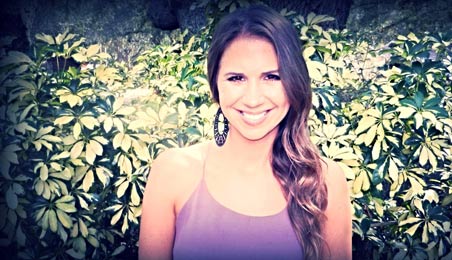Back in Rhythm
Only nine days after a craniotomy, Dana Wahlbeck was able to play the tribute she composed for her Mount Sinai neurosurgeon, Raj K. Shrivastava, MD
The Mysterious "Hotspot"
For Dana Wahlbeck, finding the rhythm within life has always been important. Not being one to let chance determine her path, Dana has embraced a multitude of opportunities, from studying at universities in Tennessee, Florida, and Ireland to landing a marketing position at a high profile company in New York City. When she is not at work, Dana unwinds with her guitar, condensing the rhythmic cadence of life’s ups and down into eloquent, relatable music.
 In March 2013, an uncomfortable discord interrupted the flow of her day-to-day life. Dana noticed a “hotspot” at the crown of her head. Puzzled by this, Dana consulted her doctor. She was told to take a Tylenol and not worry about it. Though she followed his directions, the hotspot continued to cause noticeable irritation. Without knowing how to better manage it, she kept going about her busy schedule, attempting to restore her regular rhythm.
In March 2013, an uncomfortable discord interrupted the flow of her day-to-day life. Dana noticed a “hotspot” at the crown of her head. Puzzled by this, Dana consulted her doctor. She was told to take a Tylenol and not worry about it. Though she followed his directions, the hotspot continued to cause noticeable irritation. Without knowing how to better manage it, she kept going about her busy schedule, attempting to restore her regular rhythm.
When Dana went for an annual physical, she mentioned the hotspot’s progressing irritation. To rule out potentially serious conditions, her primary care physician suggested she see a neurologist. Dana took the referral, wanting to find the cause once and for all, as it was noticeably getting worse, especially during stressful situations. A Magnetic Resonance Imaging (MRI) was taken and sent to Mount Sinai neurologist Steven Frucht, MD.
The next day, Dr. Frucht called her with the results: she had a large meningioma, which was about the size of a tennis ball, behind her left eye. He urged Dana to admit herself to the emergency room right away. While the tumor was benign, it had probably been growing gradually over the past 10 years. Since its development was so slow, her brain had adapted to its presence without signaling symptoms. If it remained any longer, the meningioma would most probably cause vision loss and seizures.
Finding the Solution
Dr. Frucht referred Dana to meningioma treatment specialist Raj K. Shrivastava, MD. Upon hearing Dana’s situation, Dr. Shrivastava immediately cleared his schedule. Before operating, Dr. Shrivastava sat down with Dana and her mother to review the possible risks and benefits of surgery. With careful consideration, they decided surgery was the best option. The surgery took eight hours, and, according to Dana: “Dr. Shrivastava did scar care so well...he took longer with my surgery to make sure the incisions would leave the least scarring possible.” Dana knew she was in good hands when she heard that he had performed over a thousand surgeries on people with similar diagnoses. However most importantly, Dr. Shrivastava made her feel understood and safe throughout the entire process. Despite the technically difficult nature of the surgery, Dana felt that with Dr. Shrivastava as her surgeon, she would be okay.
Meningiomas develop along the meninges, better known as the spinal cord and brain, and can sometimes be cancerous. While they develop slowly and do not create symptoms right away, once meningiomas start compressing on membranous material, they can be life threatening. In Dana’s case, Dr. Shrivastava performed a craniotomy, making a slight incision under the skull to access the tumor’s site. Since it sat at the base of her left sphenoid bone deep within the skull, he used stereotactic navigation, a three-dimensional coordinate system, to locate the exact location of the meningioma. This coupled with an operating microscope enabled precise identification and resection of the tumor. After removal, the skull was restored to its natural construction, with careful suturing to prevent noticeable scarring.
Rhythm Regained
Being extremely grateful for her second shot at life, Dana wanted to express her deepest gratitude to Dr. Shrivastava, but as she voiced to the Mount Sinai team, “how do you thank someone who saved your life?” Only nine days after surgery, Dana brought her guitar to share a song she wrote in honor of the incredible recovery he helped her achieve: “I wanted to give him a little piece of my heart. It was incredible to play so quickly after the surgery.” At her follow up visits, Dana proved to be making great strides. Though her full recovery is still a work in progress, she and Dr. Shrivastava remain positive and optimistic about her steady pace of recuperation.
With her smiley countenance and hopeful disposition, Dana continues to find and create her rhythm. As with any challenge, some days are better than others, but there is a reason she is able to give strength and inspiration to others— she did not let life’s unpredictable twist silence the lilts and lyrics that she has chosen to define the rhythm of her life. When asked what she would tell others to do when in doubt about their health she responded, “Pay attention to your body and advocate for yourself. Ask questions.” Indeed, it is an attitude like that— an attitude of perseverance and self-advocacy— that makes Dana’s story all the more courageous and remarkable.